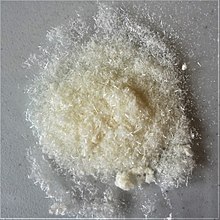Aluminum (III) acetylacetonate
| Structural formula | ||||||||||||||||
|---|---|---|---|---|---|---|---|---|---|---|---|---|---|---|---|---|

|
||||||||||||||||
| General | ||||||||||||||||
| Surname | Aluminum (III) acetylacetonate | |||||||||||||||
| other names |
|
|||||||||||||||
| Molecular formula | C 15 H 21 AlO 6 | |||||||||||||||
| Brief description |
white-yellowish powder |
|||||||||||||||
| External identifiers / databases | ||||||||||||||||
|
||||||||||||||||
| properties | ||||||||||||||||
| Molar mass | 324.30 g mol −1 | |||||||||||||||
| Physical state |
firmly |
|||||||||||||||
| density |
1.21 g cm −3 (20 ° C) |
|||||||||||||||
| Melting point |
190-193 ° C |
|||||||||||||||
| boiling point |
315 ° C |
|||||||||||||||
| solubility |
sparingly soluble in water (3 g l −1 at 20 ° C) |
|||||||||||||||
| safety instructions | ||||||||||||||||
|
||||||||||||||||
| As far as possible and customary, SI units are used. Unless otherwise noted, the data given apply to standard conditions . | ||||||||||||||||
Aluminum (III) acetylacetonate , Al (acac) 3 , is a chemical compound from the group of metal acetylacetonates. It is a complex compound with an aluminum (III) cation as the central ion and the anion acetylacetonate as the bidentate chelate ligand .
Extraction and presentation
Aluminum (III) acetylacetonate was first produced by Combes in 1887 by reacting fresh aluminum oxide, acetylacetone and hydrochloric acid. It can be produced in higher yields in the laboratory through the reaction of aluminum sulfate with acetylacetone and ammonia .
properties
Aluminum (III) acetylacetonate is a white-yellowish, crystalline powder. It is difficult in water, but readily soluble in various organic solvents and resistant to air and ammonia. Aluminum (III) acetylacetonate has an octahedral structure. This chelate complex is a chiral compound.
In a vacuum (1 mm Hg or 1.3 mbar) it can be slowly sublimated at 100 ° C and well at 156 ° C.
For further purification, it can be dissolved in benzene and precipitated again from this with the addition of petroleum ether.
use
Aluminum (III) acetylacetonate can be used, among other things, in the production of aluminum oxide at low temperatures (approx. 200 ° C).
Related links
- Copper (II) acetylacetonate
- Manganese (III) acetylacetonate
- Category: Acetylacetonate
- Category: Aluminum Connection
Individual evidence
- ↑ a b c d e f g Entry on aluminum acetylacetonate in the GESTIS substance database of the IFA , accessed on September 19, 2017(JavaScript required) .
- ↑ a b c d Ralph C. Young: Aluminum Acetylacetonate . In: WC Frenelius (Ed.): Inorganic Syntheses . tape 2 . McGraw-Hill, Inc., 1946, p. 25-26 (English).
- ^ Robert A. Chalmers, Mohammad Umar: Secondary standards: Acetylacetonates . In: Analytica Chimica Acta . tape 42 , 1968, pp. 357-364 , doi : 10.1016 / s0003-2670 (01) 80326-3 .
- ↑ a b Manisha Shirodker; Vrinda Borker; C. Nather; W. Bensch; KS Rane: Synthesis and structure of tris (acetylacetonato) aluminum (III) . In: Indian Journal of Chemistry . tape 49 , no. 12 , 2010, p. 1607-1611 ( res.in ).
- ↑ Entry on metal acetylacetonate. In: Römpp Online . Georg Thieme Verlag, accessed on January 2, 2018.


